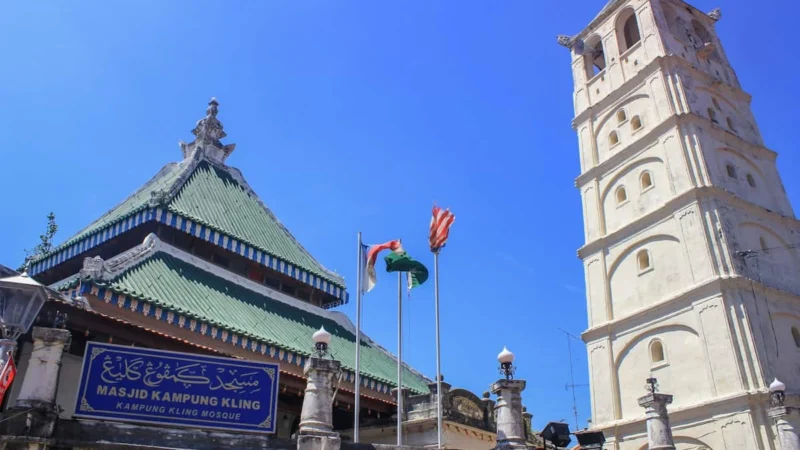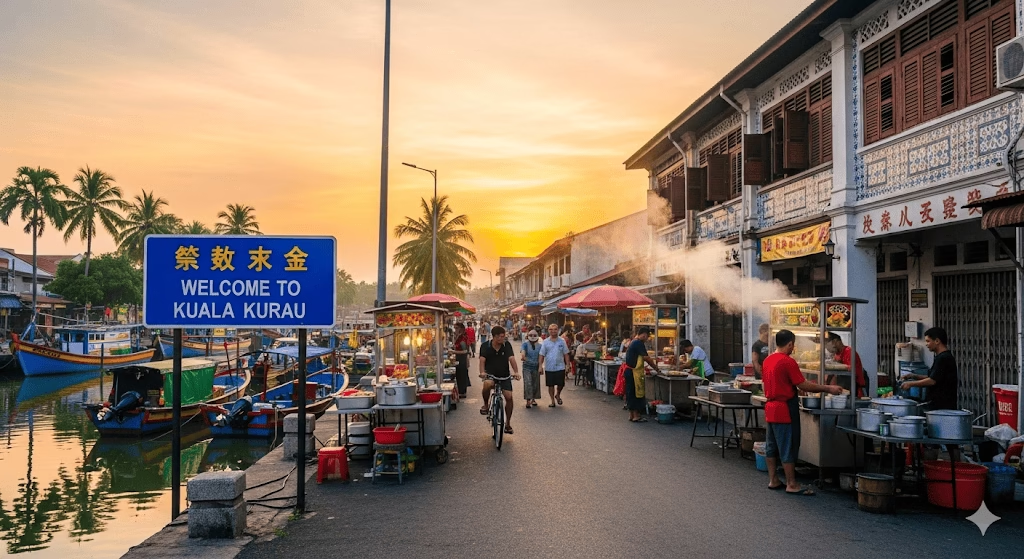Masjid Kampung Kling Melaka

Introduction
Located along the historic Jalan Tukang Emas (Goldsmith Street) in the heart of Bandaraya Melaka, Masjid Kampung Kling is one of Malaysia’s most distinctive and historically significant mosques. Built in 1748 by Indian Muslim traders, it stands as a remarkable symbol of Melaka’s multicultural identity and architectural diversity. The street it stands on is often referred to as Harmony Street, as it is also home to the Cheng Hoon Teng Temple and Sri Poyatha Moorthi Temple, showcasing Melaka’s long-standing tradition of interfaith harmony.
History of Masjid Kampung Kling
Masjid Kampung Kling was originally built as a wooden structure in 1748 by the Indian Muslim community of Kampung Kling. In 1872, the mosque was rebuilt in brick, reflecting both architectural advancement and the community’s growing influence. Despite the renovations, it retained much of its traditional design and character.
In 1999, after a careful restoration by the Department of Museums and Antiquity, the mosque was declared a historical monument, preserving its legacy as a cornerstone of Melaka’s Islamic and multicultural heritage.
Architectural Highlights
Masjid Kampung Kling is a fascinating blend of Sumatran, Chinese, Hindu, and Malay architectural styles. Unlike typical domed mosques, its design reflects Southeast Asia’s diverse influences and Melaka’s global trading connections.
Notable architectural features include:
- Triple-tiered pyramidal roof: A striking feature reminiscent of Sumatran and Javanese mosques, symbolizing layered spiritual elevation.
- Pagoda-style minaret: The minaret’s design mirrors Chinese pagodas, integrating Moorish and local Malay motifs for an East-meets-West aesthetic.
- Ablution pool and entrance arch: Built alongside the main structure, these elements highlight fine traditional craftsmanship.
- Interior details: The mosque’s interior is richly decorated with English and Portuguese glazed tiles, Corinthian columns, Victorian chandeliers, and ornamental designs reflecting Hindu, Chinese, and Malay artistry.
This fusion of diverse architectural elements makes Masjid Kampung Kling a living museum of Melaka’s cosmopolitan past.
Cultural and Religious Significance
Masjid Kampung Kling is not only a sacred place for worship but also a symbol of cultural harmony. Situated on Harmony Street, where mosques, Hindu temples, and Chinese temples coexist side by side, it embodies Melaka’s enduring unity in diversity.
The mosque remains an active religious site and a historical landmark that attracts scholars, tourists, and locals alike. It continues to promote understanding, peace, and respect among communities of different faiths.
Visitor Information
Location: Jalan Tukang Emas, Bandaraya Melaka, Malaysia
Type: Heritage Mosque
Built: 1748 (Rebuilt in 1872)
Declared Historical Monument: 1999
Opening Hours: Open daily (Visitors should dress modestly)
Nearby Attractions:
- Cheng Hoon Teng Temple
- Sri Poyatha Moorthi Temple
- Jonker Street
- Kampung Hulu Mosque
Travel Tips
- Dress modestly: Visitors are required to wear appropriate attire. Robes and scarves may be provided for non-Muslim visitors.
- Photography: Allowed, but visitors should avoid photographing individuals during prayer times.
- Timing: Visit early morning or late afternoon for a peaceful experience and soft natural lighting.
- Cultural walk: Pair your visit with a stroll down Harmony Street to explore Melaka’s rich religious diversity.
Why Visit Masjid Kampung Kling
Masjid Kampung Kling represents the harmonious blending of architecture, culture, and faith. Its rich heritage, unique design, and historical importance make it one of Melaka’s most fascinating attractions. For travelers exploring the UNESCO World Heritage Site of Melaka, this mosque offers a meaningful glimpse into the city’s multicultural soul.
Frequently Asked Questions (FAQ)
1. When was Masjid Kampung Kling built?
Masjid Kampung Kling was originally built in 1748 by Indian Muslim traders and later reconstructed in brick in 1872.
2. What makes Masjid Kampung Kling unique?
The mosque’s architecture is a blend of Sumatran, Chinese, Hindu, and Malay elements, featuring a pagoda-style minaret and a pyramidal roof instead of the traditional dome.
3. Is the mosque open to non-Muslim visitors?
Yes, non-Muslims are welcome to visit outside of prayer times, provided they dress modestly and behave respectfully.
4. Where is Masjid Kampung Kling located?
It is located on Jalan Tukang Emas (Harmony Street) in Melaka, close to Jonker Street and other heritage landmarks.
5. Is there an entrance fee to visit the mosque?
No, entry to Masjid Kampung Kling is free. However, donations for upkeep and preservation are appreciated.
6. Can visitors take photographs inside the mosque?
Photography is generally allowed, but visitors should be respectful, especially during prayer times.
Conclusion
Masjid Kampung Kling is a shining example of Melaka’s multicultural and architectural richness. Its combination of styles—Malay, Chinese, Hindu, and Sumatran—makes it one of the most unique mosques in Malaysia. Beyond its beauty, it stands as a powerful reminder of Melaka’s legacy of tolerance and unity, where people of different beliefs have lived in peace for centuries.
A visit to this mosque is not just a journey through history, but also an appreciation of Malaysia’s diverse cultural identity that continues to inspire harmony today.















Comments are closed.